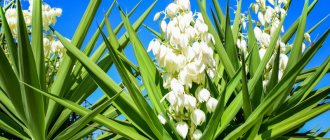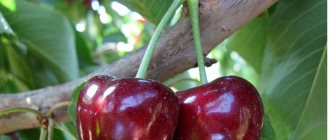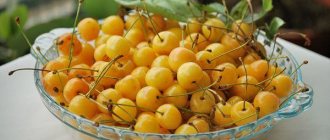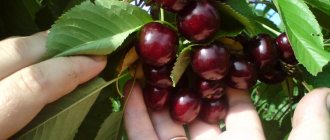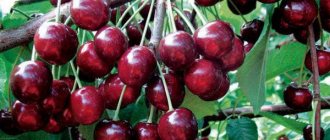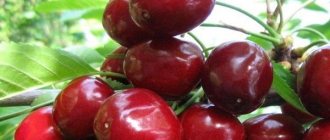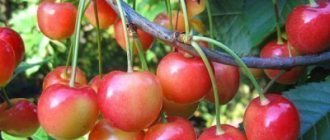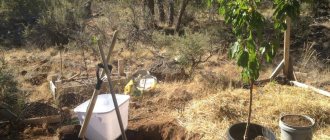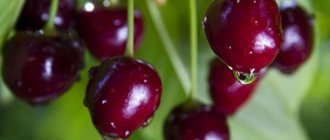History of selection
The Ovstuzhenka cherry was the result of crossing two cherry varieties: Leningradskaya Chernaya and Kompaktnaya Veniaminov. Bred by breeder M. Kanshina. The variety has been on the State Register for the 19th year. The best yield indicators are observed in the Southern Non-Black Earth Region. It is almost 2 times higher than the yield that can be obtained in other areas. The central zone of the country is also well suited for cultivation.
Cherry Ovstuzhenka - photo
Cherry Ovstuzhenka: description and characteristics of the fruit and tree
Early cherries are especially popular among domestic gardeners. The variety has good taste characteristics and is absolutely unpretentious in care. You can eat ripe fruits at the very beginning of summer.
Ovstuzhenka cherry trees bear fruit starting from the age of 3 years, but the abundant appearance of fruit can occur only in the 5th year.
Ovstuzhenka has excellent immunity
. It is resistant to diseases such as klyasterosporiosis, and is also well protected from sunburn on the bark during winter.
Photo of Ovstuzhenka cherry
An adult Ovstuzhenka cherry tree grows relatively short, is quite compact and does not take up much space on the site. It grows very quickly. The crown is shaped like a ball and sparse. The branches are spreading and directed upwards. Young shoots are approximately 1 cm thick. Those that are older reach a thickness of 5 to 8 cm. The stems and trunk are covered with a smooth dark brown bark.
Bud swelling begins in March. Flowering begins at temperatures from +10 to +12 degrees.
The leaves are oval-shaped, large in size, the tip is sharp, the plate has a smooth surface and a rich green color. The edges are jagged. The leaf is attached to the branch using a stalk.
Cherry Ovstuzhenka - video
Separately, it is worth mentioning the flowering of this variety. The Ovstuzhenka cherry blossoms begin on the 15th of May.
.
Climatic conditions also influence time. During the flowering period, the tree is very elegant and decorative. True, it does not last long. The flowering period of cherry trees of this variety ranges from a week to 10 days
. Air temperature also has an impact.
The flowers are white and large in size. The petals are round. There are 5 of them on each flower. During flowering, the tree spreads an aroma over a distance of 10 meters, which attracts insects.
Description of the variety
The “Ovstuzhenka” cherry variety is universal, so the berries are not only juicy and tasty, but also healthy, because they have tonic properties. The shape of the fruit is round or oval, the berries are large in size, the weight exceeds 4 grams and can reach 7 grams.
The color of the fruit is dark red or dark burgundy; during ripening, the color can become almost black. The dark red pulp has a sweet taste, good juiciness, has moderate density and is easily separated from the stone.
The dark color of the berries reminds us that cherry fruits strengthen the vascular system and heart muscles. Cherry fruits contain 11.6% sugar and also contain from 17.2% to 17.7% dry matter. There are 13.4 milligrams of ascorbic acid per 100 grams of cherries.
In the first 4 years, the tree grows quite quickly, rushing upward, but does not reach large sizes, and this is very convenient for caring for the tree and harvesting. The crown is raised with a spherical shape, of medium density.
The leaves are ovoid in shape on a short spine. In spring, the tree is covered with large snow-white flowers. One inflorescence consists of 3 flowers. Since “Ovstuzhenka” is partially self-pollinating, there will always be a harvest, but to increase the yield of the “Ovstuzhenka” variety, pollinating trees of the following varieties should be planted in the neighborhood: Iput, Pink Pearl, Raditsa, Tyutchevka, Bryanskaya Rozovaya, Revna. You need to plant at least three varieties.
The flowering time of the “Ovstuzhenka” cherry variety occurs in the second half of the month of May, the fruits ripen by the end of June. The cherry tree of the “Ovstuzhenka” variety produces its first harvest in the fourth or fifth year.
Description of Ovstuzhenka cherries
The fruits of the Ovstuzhenka variety are round-oval and quite large. The skin together with the pulp has a very rich wine color. The cherry pulp is juicy and soft. The taste is sweet, the aroma is rich.
The weight of Ovstuzhenka cherries can vary significantly from 4.2 to 7 g
. The size of cherries is influenced by the total number of fruits on the tree. The smaller, the larger the fruit will be. The value also depends on care: timely, sufficient watering, fertilizing. The bone inside is small.
Varieties of berries!
Grapes Augustine Gooseberry Date Blueberry Bluecrop
Harvesting and storage
Cherries are harvested when the bulk of the berries reach ripeness. This means that the size of the fruit, the color of the skin and the taste of the berry pulp will meet the requirements of this variety. Typically, the harvest of Ovstuzhenka cherries begins at the end of June, but the time of harvest ripening may shift in one direction or another from the expected harvest date, depending on the vagaries of the weather.
Did you know? Residents of Japan specially set aside free time for walks in cherry orchards during their lush, but short-lived flowering. This is a time for philosophical reflection on the fragility of beauty and all living things, as well as for composing Japanese quatrains - haiku.
Ripe berries are picked together with long stalks, which prevents the fruit from losing juice. Cherries have fairly dense, but juicy and tasty pulp, suitable for transportation over long distances. During transportation, it is necessary to observe the temperature regime (+8...+12°C), and also use special trays for berries that do not allow them to get damaged. At home, fresh berries can be stored in the refrigerator, in a special fruit compartment. The approximate shelf life of cherry berries is from 7 to 10 days.
If you find damaged fruits in the container, immediately isolate them so that they do not spoil healthy ones.
The popularity of the Ovstuzhenka cherry variety among gardeners is explained by its unpretentiousness in cultivation and high yield. Growing even one cherry tree of this variety in the garden will provide a skilled gardener with an early harvest of sweet and juicy berries.
Pollinators of the Ovstuzhenka cherry and the yield of the variety
Ovstuzhenka is recognized by gardeners as a high-yielding variety with high potential. When care is correct and sufficient, you can get at least 30 kg of ripe and tasty cherries. Those trees that are less than 10 years old produce a harvest of 15 - 16 kg.
The Ovstuzhenka variety requires pollinators, so it is worth placing pollinating cherry trees such as Iput, Revna, Tyutchevka and others nearby. They should be planted at a distance of 30 - 40 meters.
Advantages and disadvantages of the variety
Over the 19 years of existence of the variety, the main advantages and disadvantages have already taken shape.
Advantages of Ovstuzhenka cherries:
- large fruit size;
- early berry ripening;
- high taste of Ovstuzhenka cherries;
- resistance to external damage;
- good immunity;
- ability to withstand long-term transportation while maintaining taste and aroma.
Flaws:
- response to a decrease in temperature during the flowering period;
- need for pollinators.
Collection and storage of berries
From each tree you can collect up to 30 kilograms of berries. When picking fruits, it is better not to separate them from the stalk, then they will last longer. To increase shelf life, sort the berries after picking. Then put the selected cherries in the refrigerator and can be stored for 5-6 days.
The variety is perfect for business, since the tree produces a large number of berries. They withstand transportation safely and do not rot for a long time. For summer residents, Ovstuzhenka cherries are also a good choice. Compotes, desserts, preserves, jams, and juices are prepared from its fruits.
Recommended planting dates for Ovstuzhenka cherries
Ovstuzhenka cherries should be planted either in spring or autumn.
. Some gardeners agree that it is better to choose autumn for planting. In the spring, you need to wait until the snow melts completely and until the soil warms up well. As a rule, this is the 15th - 16th of April. Depending on climatic conditions and weather, the dates may shift in both directions.
If autumn is chosen for planting Ovstuzhenka cherries, then the most suitable month is October
. By this time the temperature is already low and there is enough humidity. It is best to plant in mid or late October.
How to select and prepare a site for planting
The very first thing to consider is that there should be no groundwater close to the surface of the earth. Their presence near the root system can lead to rotting of the roots, which can lead to the death of the tree.
The soil should be light and loose so that air can freely pass through it, feeding the root system. The most optimal composition: sand and black soil. Soil with kaolin and clay is not suitable. When the soil is not suitable for the plant, the branches will become crooked and begin to twist, even into loop shapes.
Ovstuzhenka: planting cherries
Experienced gardeners recommend making a planting hole in advance. For example, if you plan to plant Ovstuzhenka cherries in April, you should prepare them from October. The more time passes from digging the hole to planting, the better. During this time, all applied fertilizers will have time to decompose and evenly saturate the soil.
The dimensions of the hole for planting cherries are 0.5 x 0.6 (depth and width, respectively)
. These are not rigidly established values. It is necessary to take into account the volume of roots and the age of the seedling. It must be taken into account that the grafting site is not buried in the ground. The roots should not be crowded.
Attention!
When digging a hole, the top layer is temporarily removed to the side. When everything is ready, you can pour it back in. The best feeding is 3-year-old manure. You can add humus or compost.
For one pit, 5 to 7 kg of organic matter is enough
. Additionally, ammonium sulfate and triple superphosphate are added. Only in the size of 100 g. After this, add black soil and mix everything well.
A mound with a height of 15 to 20 cm should form at the bottom of the planting hole. Now everything is ready. You can place a seedling.
How to properly plant and care for cherries
Landing
The planting site is selected high and well-lit, without nearby groundwater flow. It is necessary to protect the plant from cold winds. Before manipulation, the roots are immersed in water with a growth stimulator for several hours.
In warm regions, autumn planting is recommended, and in the Moscow region - spring planting. Form holes 0.8 x 1 m wide. Fill one third with the mixture: 1 kg of wood ash, 3 kg of superphosphate, 2 buckets of soil, 1 kg of potassium sulfate, 30 kg of rotted manure or compost. Under such conditions, seedlings are sent to pits immediately in spring, and after 2 weeks in autumn.
The process of planting Ovstuzhenka cherries
Ovstuzhenka seedlings are soaked in water 24 hours before the planned planting
. The roots will be properly saturated with water. Before planting, the root system is placed in a thick liquid.
Its composition includes: clay, mullein, water. The mixture should look like thick sour cream.
The young plant is placed directly in the center on the mound. The root system must be carefully straightened downwards. Not far from the seedling, 20–30 cm apart, place a peg as a support and tie the tree. The height should be approximately the same.
Next, you will need help to hold the seedling and support in the position in which it was installed. From time to time it is necessary to shake the seedling. The soil will settle evenly over the entire root system. After filling the hole halfway, it is filled with a bucket of water. It should be completely absorbed, after which soil is added to the hole again.
Important!
The grafting site does not need to be covered with soil.
At the very end of planting Ovstuzhenka, a depression is formed around the trunk of the tree
. It should be wide. This makes watering convenient. In this case, the moisture will definitely reach the entire root system. The soil is compacted.
The young cherry is secured with a belt made of leather or soft, strong fabric in the shape of an “8”. For several years, a peg is simply necessary so that the still fragile plant does not break.
Watering is carried out again. After it is absorbed, if necessary, add soil to the holes formed after watering in places where the soil settles.
Interesting!
25 best varieties of cherries for growing in Siberia Leningradskaya black cherry
Further tree care
In order for the tree to bear fruit every year, the Ovstuzhenka cherry tree needs appropriate care.
. It includes watering, fertilizing, protection from diseases and insects, pruning, and cleaning the soil around the trunk.
In spring and autumn, digging is done near the trunk of the cherry tree. Loosening is carried out to a depth of 10 to 12 cm. This helps remove weeds and prevents their appearance. It is easier to fertilize such soil.
Well-loosened soil acts as mulch and is an excellent protection for the layer at the roots from moisture loss. Before the onset of winter, the soil should also be well loosened.
How to water cherries
The first month requires watering once every 7 days.
. About 10 liters of water are poured under the root. Stop watering only in winter, as well as during constant rain.
After this, watering is reduced to once every 14 days over the next couple of months, after which it is again made more frequent to once a week. Before planting, cherry seedlings should be protected from the sun to prevent them from drying out.
How to water cherries
In summer, an adult Ovstuzhenka cherry tree is watered once a month, but at least 20–30 liters of water are taken
. Watering is especially important when fruits are forming. In spring, water in the very last days of April. In this case, 100 liters per plant are needed. It is convenient to simply place the hose next to the tree and adjust the amount of incoming water.
The hose can even be left overnight. In autumn, watering of cherries is also carried out in the second half of October. Watering is carried out in furrows, which are located at a distance of 25 to 30 cm from the trunk.
Fertilizing Ovstuzhenka cherries
It is worth feeding Ovstuzhenka cherries only in the 5th year, since the previously added organic matter when preparing the planting hole is quite enough.
How to feed cherries
Every couple of years, mature trees are fed with organic matter, spreading sufficiently decomposed horse manure in a circle near the trunk on the soil surface with a diameter of 1 meter.
The organic layer should be from 8 to 10 cm thick. One adult plant requires 2 buckets of well-rotted manure. Everything is carefully dug up. After 2 years, fertilizing is repeated.
Growing a tree
Cherries should be grown in soil rich in clay or sand. You cannot plant it on peat, clay or sandy soil. When selecting sandy soil, pour several buckets of clay at the bottom of the hole, and if the soil is clay, add 2 buckets of sand.
Choosing a place and time of landing
The cherry variety prefers to grow in a place where the north wind does not blow and the sun's rays constantly shine. The tree should be planted on a southwestern or southern slope. It is better to give preference to a low elevation, or do it yourself: raise the ground level by half a meter. The location should have a low groundwater level, and its depth should be 1.5 meters.
See also
Description and characteristics of the Bigarro Burlat cherry variety, planting and careRead
In warm areas, plant the tree in the fall to allow it to take root. In the Moscow region, spring planting is more suitable. From mid to late April, prepare the site and place the seedlings. The soil should have time to warm up by then. If we are talking about autumn planting, it occurs in mid-October. The earth is not dry from the heat, but is still warm.
Selection of seedlings
It is important to choose planting material wisely. Experienced gardeners advise buying seedlings from a nursery. It should have a central conductor and a large number of sprouts. It is worth purchasing planting material that is 1 or 2 years old. Only a correctly selected seedling will form the required crown, which will contribute to branching.
In the absence of a guide, the shoot will break under the weight of the fruit. The tree must have a grafting site, which serves as an indicator of the variety.
Planting process
Plant cherries at a distance of 3 to 5 meters from each tree to ensure successful rooting. One is 12 square meters or more.
If planting takes place in the spring, it is necessary to prepare the site in the fall:
- dig holes 0.8 meters wide and 1 m deep;
- pour a mixture of 1 kilogram of wood ash, superphosphate, a bucket of soil, 1 kilogram of potassium sulfate, 30 kilograms of rotted manure into the recesses by a third.
When carrying out such preparation, seedlings are planted immediately. If the process is planned for the fall, two weeks of preparation is required.
Pollinators
The variety is self-fertile; ovaries grow from 10% of flowers, even in the absence of a pollinator nearby. To ensure a large harvest, you need to plant trees that bloom early next to large-fruited cherries. There should be a distance of 2.5-3 meters between them.
Preferred pollinators for the Ovstuzhenka cherry variety:
- And the way;
- Bryansk pink;
- Raditsa;
- Red hill.
If there is no free space on the plot, you can graft several rows of varieties onto one tree.
How to whiten a cherry tree trunk
It is recommended to whitewash Ovstuzhenka cherries in early spring and late autumn. It is also possible in winter. Whitewashing gives a decorative look. However, this is not the main goal. It is done to keep the tree healthy. This procedure protects against burns.
Attention:
In case of sunburn, it is necessary to immediately treat these areas with garden varnish. Otherwise, activation of viruses and fungi is possible.
First of all, prepare a solution for whitening cherries, which includes:
- water – 10 liters;
- quicklime – 1 kg;
- fresh manure - 1 shovel.
For preparation, take a bucket made of metal or plastic. First, lime is mixed with water to allow a bubbling reaction to occur. Only then do they add manure. Mix everything well.
How to whitewash trees?
You can additionally, if desired, add copper sulfate in the amount of 100 grams, which acts as a fungicide. It has an antibacterial effect.
The finished solution is applied with a simple paint brush. The pile should be long. Whitewashing is carried out from the bottom up, affecting the lower part of the main branches. Enough for 50 cm.
The procedure for whitewashing Ovstuzhenka cherries should be carried out on a sunny day, without precipitation.
It is possible in winter, in the first 2 months. By the way, it is in winter that the sun's rays are more intense and can cause more damage to the tree, as they are reflected from the snow.
Harvest Ovstuzhenka
The fruits of Ovstuzhenka begin to be harvested at the end of June. Ripe berries acquire a dark color. The pulp and juice of the fruit are dark burgundy, rich. Tasters rate the taste qualities of Ovstuzhenok at 4.7–4.9 points on a five-point scale: the cherry is sweet, juicy, dense, aromatic. The variety is considered dessert and universal. Well suited for both fresh consumption and processing. Sweet cherries make delicious compotes, preserves, and jams.
Ripe cherry fruits acquire a dark burgundy color
It is better to pick berries on a sunny day so that they are dry. To increase shelf life, cherries are picked along with the cuttings. In this form, the fruits will be stored in the refrigerator for up to 2 weeks. If desired, you can freeze the berries: they will not lose their taste and can be stored for up to 6 months.
Pruning and shaping Ovstuzhenka cherries
Cherry Ovstuzhenka requires pruning, which is carried out in spring and autumn every year.
There are two types of pruning:
- sanitary;
- formative.
Sanitary pruning is necessary for mature trees
. Remove all dried, old branches. Those that are broken are cut out either completely or partially.
Formative pruning is done for young Ovstuzhenka cherry trees
. Carry out until the crown acquires a stable shape.
Pruning is required to produce a higher quality crop.
How to shape cherries
The procedure for forming the crown of the Ovstuzhenka cherry is as follows:
- The first pruning of Ovstuzhenka is carried out after planting the seedling, when all excess is cut off, leaving the seedling approximately 60 - 70 cm in height.
- 3-4 of the side branches are left, the remaining branches are considered unnecessary and are cut off.
- Formation continues next year. Occurs in the form of trimming the tips of the branches and the top of the tree by 15 - 20 cm. As a result, the top should look longer compared to the branches located on the sides.
- 3 shoots are left on the side branches, pinching off their tips. These are 2nd order branches.
- In the 3rd year, the top and branches are also pruned by 10–15 cm. Also, 3 shoots are left on the 2nd order branches. These are already branches of the 3rd order and so on.
- All unnecessary shoots are removed. Formation is complete.
In the future, only sanitary pruning is necessary.
Cherry Fatezh.
The trees are medium-sized, about 4 m tall. The crown is spherical, spreading, drooping, of medium density, skeletal branches extend at a right or obtuse angle. Fruits average weight 4-6 g, one-dimensional, round, red-yellow. The taste is sweet and sour, dessert, the flesh is dense, juicy, light pink, the stone is medium-sized, oval, easily separated from the pulp. The best pollinator is Chermashnaya, Iput. Winter hardiness is above average (at the level of Vladimir cherry), resistant to the most dangerous fungal diseases - moniliosis and coccomycosis.
Cherry diseases and pests
Sweet cherries, like other garden crops, are susceptible to diseases and pest attacks.
The most common cherry diseases:
Moniliosis
. The most dangerous disease for cherries. Flowers and leaves turn brown and dry out. When the disease is advanced, the branches also die. Mold forms on the fruits, rapid rotting and shedding of cherries occurs.
To combat the disease moniliosis, the following drugs are used for cherries: Topsin M 500 SC, Switch 62.5 WG, Miedzian Extra 350 SC, Signum 33 WG.
Clusterosporiasis
. Occurs due to fungal infection. The defeat begins with the leaves. In spring, brownish-red spots form. Gradually they affect the entire leaf blade. The disease generally weakens cherries. To prevent further development of the disease, remove all fallen leaves, since fungal spores usually overwinter in them.
To treat cherries from clasterosporiasis, spraying with such preparations as: Carpene 65 WP, Kaptan Plus 71.5 WP, Topsin M 500 SC is used.
Among the pests Ovstuzhenka can be affected by:
- cherry fly;
- May beetle, or Khrushchev;
- cherry aphid;
- flower beetle
Pests are controlled using insecticides.
Among them: “Mospilan 20 SP”, “Antikhrushch”, Calypso 480 SC. Cherry Ostuzhenka is a fairly popular variety
. The reason for this is productivity, good taste and easy care. This is a worthy choice for any garden plot.
Winter-hardy cherries - varieties for the Moscow region and central Russia
The best self-fertile varieties for the Moscow region and the middle zone
The self-fertility of varieties lies in the ability of fruit trees to self-pollinate with their own pollen. Those that form 20–40% of the fruits from the total number of flowers are considered self-fertile. Self-fertile varieties do not require cross-pollination with other varieties. Their advantage is that they are independent of the flight of pollinating insects.
But today there are not so many self-fertile varieties of cherries. Therefore, even with such trees, it is better to plant pollinating varieties nearby, which in any case will help increase productivity.
The best varieties of self-fertile cherries for the Moscow region today are recognized as:
- Narodnaya Syubarova is considered the best option throughout Russia. True, you shouldn’t expect a huge harvest; 50 kilograms from one tree is the limit; you can’t collect more even in the most successful year. The berries of this cherry are medium in size. The tree itself is tall, with a powerful trunk and branches that can withstand the load of snow or wind. The plant is highly self-pollinating, the fruits ripen up to 90%. The seedlings take root well and are able to grow even on sandy and loamy soils.
- Ovstuzhenka is a frost-resistant cherry that can withstand down to -45 degrees. It is conditionally self-fertile, since pollination takes place within one tree, the resulting ovaries are no more than 90%. Medium large berries, from 4 to 7 grams. The harvest is 30-50 kg per tree. The tree is not tall, which allows it to be grown on an industrial scale.
- Revna is a small plant with a pyramidal crown. Self-fertile, very prolific, not large-fruited, its berries are not large, but very sweet and aromatic. Cold-resistant, can withstand frost down to -6 degrees during the flowering period. It is highly transportable, can be stored for a long time, and is dense and not watery at maturity.
Early winter-hardy and late varieties of cherries
Almost all known varieties of cherries are mostly self-fertile, and only a few species are self-fertile, and then only partially, since they also require pollinating varieties for a full harvest. Therefore, when choosing a variety to plant in your garden, you need to immediately buy a pollinator plant in pair with it, which will have the same flowering period. Cherries are divided into 3 groups according to flowering time.
Winter-hardy early varieties of cherries:
- Iput is frost-resistant and bears good fruit. Pollinators can be Revna and Raditsa.
- Homestead yellow - a self-fertile variety, frost-resistant, vigorous, slow-growing, fairly productive. The berries are medium, sweet and sour.
- Gronkavaya is a strong, frost-resistant variety. The fruits received a high dessert rating. Suitable pollinators: Cheremashnaya, Raditsa, Iput, Fatezh and Ovstuzhenka.
- Krasnaya Gorka - less resistant to diseases, the berries were highly appreciated. Pollinators, like Iputi.
- Ovstuzhenka - refers to partially self-fertile varieties, the fruits are rated well. It is good to plant Iput cherries next to them.
Mid-season cherry varieties:
- Rechitsa - belongs to the varieties of the bigarro group, frost-resistant, not large-fruited, with very sweet dark red berries. Resistant to diseases. Among the pollinators, it is better to choose Pink Pearl, Adeline and Ovstuzhenka.
- Leningradskaya black from the guinea group. Sweet, medium-sized berries with pulp that cannot be separated from the seeds. The tree is of medium height, has little resistance to frost, and is not capable of self-pollination. Pollinators: Iput, Revna, Bryanochka, Tyutchevka and Veda.
- Leningrad pink - also belongs to the gini group. Small berries with delicate, yellowish skin with ruddy barrels, the flesh is sweet and yellow. The plant is quite tall, has a lush crown, and does not self-pollinate. It is recommended to plant next to the following varieties: Adeline, Chernyshevsky, Pink Pearl and Rechitsa.
- Tyutchevka is a medium-sized tree, very resistant to cold and disease. The berries are bright red, medium in size, well suited for freezing and transportation. The plant is partially self-pollinating. Recommended pollinators: Iput, Raditsa and Ovstuzhenka.
- Large-fruited - a tall, fast-growing tree with a wide crown of medium density. Large-fruited cherries have dark red berries, the weight of which is 10-12 grams, and are considered a dessert variety. The best pollinators will be Surprise and Oratovsky.
Late ripening varieties:
- Michurinka is not a tall tree, resistant to drought and disease. The berries are dark red, strong, fleshy and sweet. They are stored for a long time and transported well. The variety is self-sterile. Pollinators required: Michurinskaya late and Pink pearl.
- Bryansk pink belongs to the bigarro group. The berries are medium-sized, about 5 grams, with sweet pink pulp that cannot be separated from the seed. The following varieties are suitable for pollination: Iput, Revna, Ovstuzhenka and Tyutchevka.
Yellow cherry that is not afraid of birds
Birds love to peck red cherry fruits, especially early varieties. If the garden is located near a forest, rowan thrushes flying from it can destroy the entire berry crop in a matter of hours. Therefore, it is better to cover the red-fruited varieties of the Moscow region with a net during their fruiting period.
Yellow cherries are not afraid of this misfortune - birds do not touch its berries, and the harvest remains intact. In addition, red fruits do not tolerate heavy summer rains and often crack. Yellow cherries, unlike red-sided cherries, do not have such a disadvantage.
The most common cherry variety found in the Moscow region is “Yellow Priusadabnaya”. It is from the early ripening varieties of the bigarro group. The berries are medium-sized, weighing about 5-6 grams; their pulp, like the peel, is yellow, sweet, but with a slight sourness. Yellow Household loves black soil, so it takes root well in the middle zone.
Features of the variety:
- self-pollinating tree, has high yields;
- Fruiting begins quite late - in the 6th year, while ordinary trees begin to bear fruit in the fourth year;
- frost-resistant variety, resistant to fungal diseases, not afraid of cherry flies;
- requires frequent pruning and removal of shoots, since the tree reproduces quickly and has a very lush crown.
Low-growing trees - small and remote
To achieve high yields on a small planting area, columnar fruit trees are increasingly being used, since there is less care and consumption of associated materials, and mechanized harvesting is also applicable to them. Among the thousands of cultivated varieties known in the world, tall ones predominate.
And only a few of them, such as the yellow Fatezh cherry, have relatively moderate growth. To develop short cherry varieties, modern breeders have used several methods to suppress the dominant tall gene. We will tell you about two of them.
- Raising dwarfism donors. Cultivated large-fruited cherries are usually grown on antipka seedlings, which are vigorous rootstocks. To reduce the height of the tree, low-growing rootstocks are used. Clonal cherry rootstocks known today have a wide range of possible crown reduction, which is 20-90%. The effectiveness of using low-growing rootstocks was noted by world breeders, industrial gardeners and private farms. Thanks to recent research, the prospects for using dwarf cherry rootstocks have been confirmed, which has influenced the further development of breeding work in this direction.
- Exposure of test samples to radiation. This method is based on causing a mutation in plants that suppresses the dominant traits of their tallness. As a result of the work of Canadian specialists, low-growing varieties of cherries were developed - dwarf varieties Compact Lambert and Compact Stella. The resulting columnar forms have earlier periods of full fruiting than large-fruited tall cherries.
But, despite many advantages, even the best columnar varieties have a number of disadvantages. Flower buds of weak-growing cherry rootstocks have low resistance to spring frosts, which often leads to a noticeable loss of part of the harvest. In addition, the buds of dwarf trees bloom earlier than those of tall plants, which can lead to the threat of freezing.
Another significant disadvantage of columnar cherries is their excessive yield, since the fruits ultimately lose significantly in size, which affects their market value. To prevent this phenomenon, the crowns of columnar trees need regular adjustments aimed at regulating the crop load.
nasotke.ru
Cherry Ovstuzhenka: reviews from gardeners growing the variety
Tatyana Lvovna, 58 years old, Voskresensk Cherry is one of my favorite crops. Four years ago my husband and I purchased a garden plot. I immediately decided to make a small cherry orchard. We stopped at Ovstuzhenka. Of the pollinators we chose for our cherries, Ovstuzhenka chose the Tyutchev variety. We listened to the recommendations of family friends - they are experienced summer residents. I immediately liked the taste of the berries. Caring for the variety is not difficult, considering that we have practically no experience in caring for any garden crops at all. And in the third year they bore fruit! In my opinion, it is important to properly prepare the hole for planting, fertilize it with organic matter and leave it for at least a couple of months. And further care, as expected. A variety worthy of attention. I recommend.
Alexander Stepanovich, 69 years old, Bryansk I have been growing Ovstuzhenka for a very long time. You can say from the very beginning of its appearance. I immediately liked the easy-to-care, sweet, juicy taste. Caring for Ovstuzhenka cherries is simple: watering, pruning, fertilizing, whitewashing. During all this time, the trees were sick a couple of times. Immunity is generally good. Care is not the last thing here. Productivity is good. Reaches up to 20 kg from an adult tree.
Lyubov, 47 years old, Smolensk Ovstuzhenka is my favorite variety. The neighbors in the dacha treated me. I also decided to plant it on my site. Planted in the spring. The tree took root immediately. I tied it to a peg and quickly got stronger. Now I can't stop looking at him. And how it blooms: both beautiful and fragrant... I make compotes and fruit drinks from the fruits. We eat it with the whole family and fresh. Very tasty cherries.
Characteristics of the variety
Cherry Ovstuzhenka: photo of the variety
The main characteristic of the Ovstuzhenka cherry variety is considered to be versatility. Quite tasty and healthy fruits with tonic characteristics can be consumed both fresh, unprocessed, and processed for storage. This variety is also very popular among farmers due to its resistance to cold, due to which the subspecies is grown in various weather conditions. This plant is often grown in private gardens due to its unpretentiousness and excellent early harvest.
As practice has shown, the Ovstuzhenka cherry variety is able to withstand frosts down to -45 degrees, therefore, as mentioned above, this tree is cultivated in absolutely all regions of Russia. Speaking of the dry period, this crop requires timely watering procedures. A tree of this variety is considered a rather moisture-loving crop. During watering, one such tree should require approximately 20 liters of water.
The flowering period of this plant begins in the second half of May. The tree is covered with inflorescences consisting of three large, white flowers. A distinctive feature of this subspecies of cherries is the high resistance to cold of vegetative and flower buds. At the moment when the berries of this tree acquire a dark shade, the onset of ripeness and harvest comes. Typically, fruit ripening occurs in the last week of June, and in the southern regions the berries are fully ripened by mid-June, while the Trans-Ural regions begin to harvest one month later. Pollinators of the Ovstuzhenka cherry are simultaneously flowering subspecies.
The Ovstuzhenka cherry forms a huge number of ovaries after the flowering period, if other subspecies of this crop grow near it. In this case, from one such plant you can collect up to 32 kilograms of ripe fruits, which, in turn, is considered a high indicator. Such scientific tests were carried out, after which the yield from one hectare of such plants was up to 206 centners per year. To ensure good preservation of the berries, they need to be picked when harvesting along with the stalk. Otherwise, the beneficial composition of substances threatens to be lost. The fruits are not prone to cracking, so they can be easily transported over long distances. It is worth noting that at an air temperature of more than 6 degrees and a humidity of more than 80 percent, the fruits of this variety retain their freshness during storage.
Cherries are considered to be quite a healthy berry. The fruits of Ovstuzhenka cherries can strengthen blood vessels and the heart. Their chemical composition contains the entire spectrum of multivitamins, which is considered sufficient to compensate for deficiency during vitamin deficiency. Such fruits are eaten fresh, although various compotes, desserts and jams from these berries also turn out excellent. The fruits of this subspecies can be frozen.
In order to avoid infection of this plant with fungal diseases, the tree trunk should be sprayed and treated with whitewash for preventive purposes. It is worth mentioning such an important fact as the presence of immunity in this variety to such common and dangerous diseases as moniliosis and coccomycosis, which, in turn, is very attractive to gardeners. You should also take preventive measures against insect pests. Although this tree should be provided with very good protection from rodent attacks and cold winds.
Like any other cherry variety, Ovstuzhenka has its advantages and disadvantages. The advantages of this culture include:
- A high level of frost tolerance, thanks to which the variety can grow in any region of Russia.
- The tree is small in size, making it simple and easy to care for and harvest.
- The fruits are large in size and have excellent taste characteristics.
- Immunity to fungal diseases.
- Early ripening.
- High level of productivity.
The disadvantages of the Ovstuzhenka cherry variety include the following:
- Low self-pollination rate, about 10 percent.
- Low level of cold resistance of plant stems.
